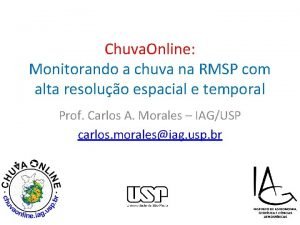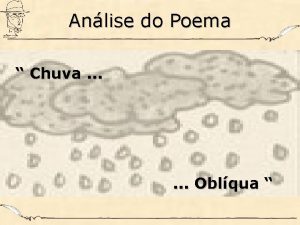CHUVA Project CHUVA Cloud processes of t He







- Slides: 7

CHUVA Project CHUVA - Cloud processes of t. He main precipitation systems in Brazil: A contrib. Ution to cloud resol. Ving modeling and to the GPM (Glob. Al Precipitation Measurement) Proposal accepted in September 2010

CHUVA Project CHUVA - Project WORKING GROUP – 1 CHARACTERISTICS OF THE PRECIPITATING SYSTEMS AS FUNCTION OF THE REGION AND LIFE STAGE Responsible : Luiz Machado WORKING GROUP – 2 PRECIPITATION ESTIMATION – DEVELOPMENT AND VALIDATION ALGORITHM Responsible : Carlos Angelis WORKING GROUP – 3 ELETRIFICATION PROCESS: MOVING FROM CLOUDS TO THUNDERSTORMS Responsible: Carlos Morales WORKING GROUP – 4 CHARACTERISTICS OF THE BOUNDARY LAYER FOR DIFFERENT CLOUD PROCESSES AND PRECIPITATION REGIMES Responsible: Gilberto Fisch WORKING GROUP – 5 MODEL IMPROVEMENTS AND VALIDATION, WITH FOCUS IN CLOUD MICROPHYSICS AND AEROSOL INTERACTIONS, FOR SATELLITE PRECIPITATION ESTIMATES IN BRAZIL Responsible: Maria Assunção Dias NASA Precipitation Measurement Missions Science Team -26 -29 October 2009 - Salt Lake City

CHUVA Project CHUVA has the Objective of Answer or improve the knowledge about the following basic question • How to estimate rainfall from warm clouds? • What is the contribution of rain from warm clouds to the total precipitation in different regions of Brazil? • How to improve both space and time precipitation estimation of rainfall over the continent for the GPM constellation? • What are the average characteristics (3 D - cloud processes) of the main regimes of precipitation in Brazil? • What is the contribution of the aerosol in the process of formation of precipitation? • What are the main surface and boundary layer processes in the formation and maintenance of clouds? • How cloud microphysics and electrification processes evolves during the cloud life cycle? NASA Precipitation Measurement Missions Science Team -26 -29 October 2009 - Salt Lake City

CHUVA Project – Field Campaign NASA Precipitation Measurement Missions Science Team -26 -29 October 2009 - Salt Lake City

CHUVA Project – Field Campaign Schedule NASA Precipitation Measurement Missions Science Team -26 -29 October 2009 - Salt Lake City

CHUVA Project - INSTRUMENTATION PACK The typical instrumentation pack to be used in the field campaign: Dual Polarization Doppler X band radar ADDITIONAL DATA EZ Lidar ALS 450 Satellites images: Microwave Radiometer MP 3000 CPTEC analysis 6 Laser Disdrometer Radiosondes from Brazilian network Surface Station (raingauge) 3 Meteorological Surface Stations Brasildat network - Brazilian lightning detection network): 2 Field Mill STARNET (South American lightning network) Radiosonde RS-92 Turbulent fluxes of heat and moisture GPS Station Soil Moisture Airplane equipped with cloud microphysical instrumentation (only some campaigns) Rain gauges CCD cameras Vertical pointing radar – micro rain radar Low-light Level CCD cameras NASA Precipitation Measurement Missions Science Team -26 -29 October 2009 - Salt Lake City

CHUVA - Participants 72 Brazilian Researchers and Engineers NASA Precipitation Measurement Missions Science Team -26 -29 October 2009 - Salt Lake City













